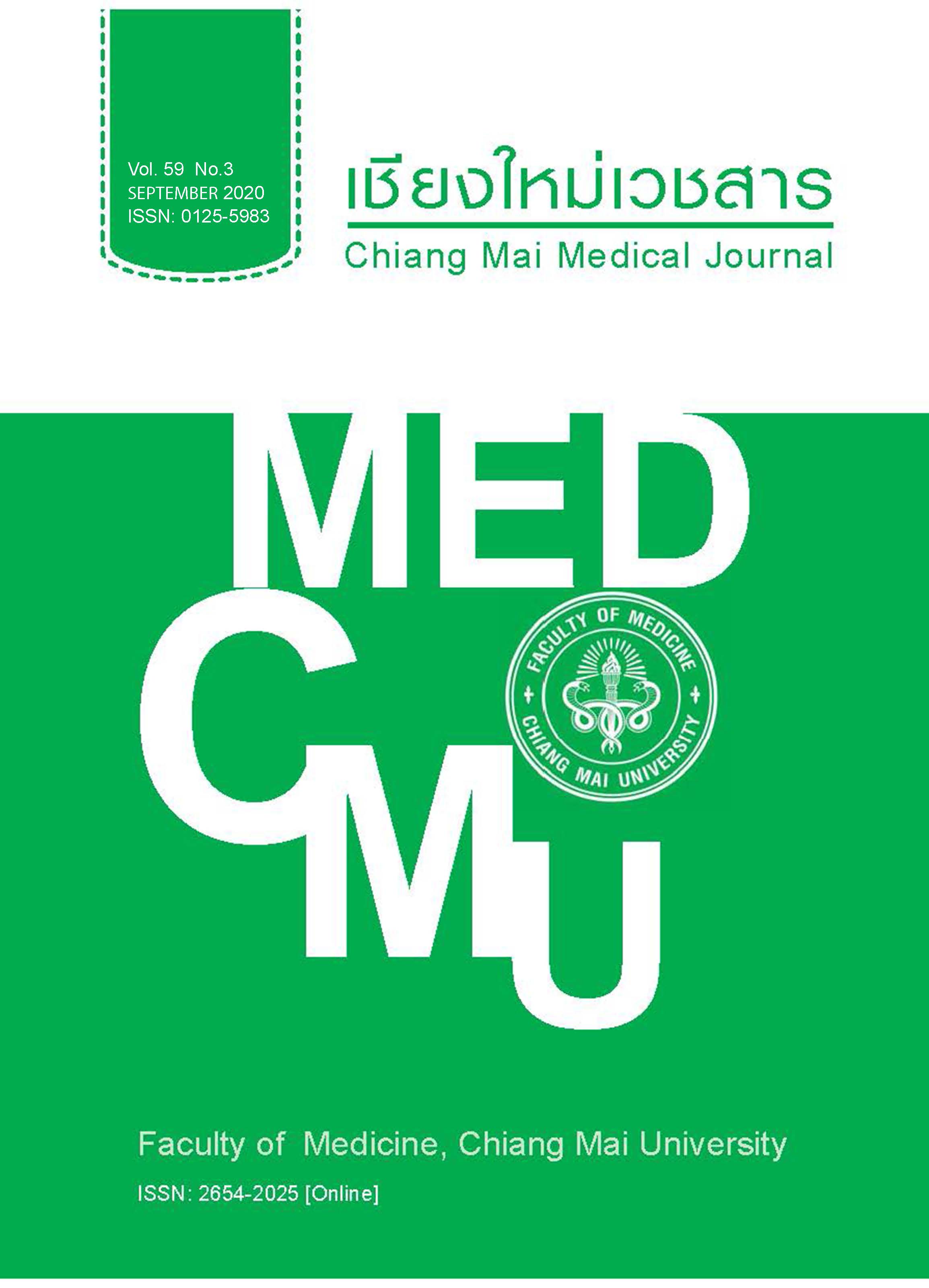Development of clinical nursing practice guidelines for discharge planning among neurosurgical patients in transitional and end of life stage of palliative care, Maharaj Nakorn Chiang Mai Hospital
Keywords:
discharge planning, neurosurgical patients, palliative careAbstract
Objectives This study aims to develop clinical nursing practice guidelines, and investigate the feasibility of implementing the guidelines for discharge planning among neurosurgical patients in transitional and end of life stage of palliative care, Neurosurgical Ward, Maharaj Nakorn Chiang Mai Hospital.
Methods This research is a developmental study based on the concept of a 12-steps clinical practice development of the Australian National Health and Medical Research Council, conducted between November 2014 to August 2017. The samples were divided into two phases: 1) clinical nursing practice development phase, and 2) trial clinical nursing practice phase. Data were collected using personal data questionnaires, clinical nursing practice guideline questionnaires, and overall clinical nursing practice opinion questionnaires. The data were analyzed using descriptive statistics.
Results The clinical nursing practice guidelines for discharge planning among neurosurgical patients in transitional and end of life stage of palliative care includes 25 recommendations, divided into four phases: 1) assessment phase: provision of timely and informative risk screening; 2) planning phase: commencement of the preparation of a discharge plan; 3) implementation phase: timely notification of community providers and provision of a timely and informative discharge summary; and 4) evaluation phase: follow - up of discharge plan. Clinical nursing practice guideline users view that there is an implementation feasibility from 80 to 100 percentages of 25 recommendations, and the content of all clinical nursing practice guidelines should be preserved.
Conclusions The clinical nursing practice guidelines were feasible for discharge planning among neurosurgical patients in transitional and end of life stage of palliative care and could be operated the quality of discharge planning audit form.
References
Norasetthada T. Outcome of head injury before and after residency training of neurosurgery in Chiang Mai University. Neurological Surgery. 2010;1:112-9. [in Thai]
Somporn P, Rattanalert S, Oearsakul T. Surgi-cal outcomes in acute traumatic subdural hematoma at Songklanagarind Hospital. Neurological Surgery. 2010 1:120-1. [in Thai]
Mokcharoenpong C. Palliative care in Practice [online] 2012. [cited 2017 August 23]. Available from: http://bit.ly/1VfCmup. [in Thai]
General Neurosurgery Unit. Re-admission rate in 2013-2014. Chiang Mai: Maharaj Nakorn Chiang Mai Hospital, Faculty of Medicine; 2014. [in Thai]
Nursing Department, Maharaj Nakorn Chiang Mai Hospital. Polices and guidelines of Palliative care [online] 2012 [cited 2015 Jun 6]. Available from: https://www.med.cmu.ac.th/hospital/nis/
Turner-Stokes L, Sykes N, Silber E, Sutton L, Morrey V, Holmes T, et al. Long-term neurological conditions: management at the interface between neurology, rehabilitation and palliative care [online] 2008 [cited 2016 August 11]. Available from: https://www.rcplondon.ac.uk/guidelines-policy/long-term-neurological-conditions
Pichitpornchai W, Saneha C, Tosuksri W, Koositamongkol S. Discharge planning: Concepts and Methods. In: Pichitpornchai W, Asdornwised U, editors. Discharge planning: concepts and application. 2nd ed. Bangkok: Niyom Vittaya; 2003. p. 1-10. [in Thai]
Jackson MF. Discharge planning: Issuses and challenges for gerontological nursing. A critique of the literature. J Adv Nurs [serial on the Internet]. 1994;19:492-502. [cited 2015 May 21] Available from: https://onlinelibrary.wiley.com/doi/abs/10.1111/j.1365-2648.1994.tb01112.x
Allaudeen N, Vidyarthi A, Maselli J, Auerbach A. Redefining Readmission Risk Factors for General Medicine Patients. J Hosp Med [serial on the Internet]. [cited 2015 January 9]. 2011;6:54-60. Available from: https://www.ncbi.nlm.nih.gov/pubmed/20945293.
Enguidanos S, Vesper E, Lorenz K. 30- day readmissions among seriously ill older adult. J Palliat Med 2012; 15: 1356-61.
The Institute of Hospital Quality Improvement & Accreditation. Hospital and Healthcare standard, Sixtieth Anniversary Cerebrations of His Majesty’s Accession to the Throne Edition [online] 2006. [cited 2015 June 7]. Available from:http://49.231.246.209/lpnh2020/files/quality/HA-standard-thai-version.pdf. [in Thai]
Asdornwised U. Patient discharge planning model. In: Pichitpornchai W, Asdornwised U, editors. Discharge planning: concepts and application. 2nd ed. Bangkok: Niyom Vittaya; 2003. p. 11-7. [in Thai]
Health Service Research Unit. Performance Indicators for Effective Discharge. Melbourne Victoria: Victorian Government Department of Human Services; 2000.
Nantachaipan P. The CPGs quality evaluation questionnaire. Chiangmai: Faculty of Nursing; 2006. [in Thai]
Joanna Briggs Institute [JBI]. The JBI Approach to Evidence-Based Practice. [online] 2014 [cited 2015 January 15]. Available from: http://www.joannabriggs.edu.au/pdf/about/Approach.pdf
Promchan P. The development of discharge planning model for intracerebral hemorrhage patient undergone surgery by multidisciplinary team Neuro Surgical Department Udonthani Hospital. [An Independent Study Report for the Master of Nursing Science in Nursing Administration], Khon Kaen: Khon Kaen University; 2009. [in Thai]
Downloads
Published
How to Cite
Issue
Section
License

This work is licensed under a Creative Commons Attribution-NonCommercial-NoDerivatives 4.0 International License.










